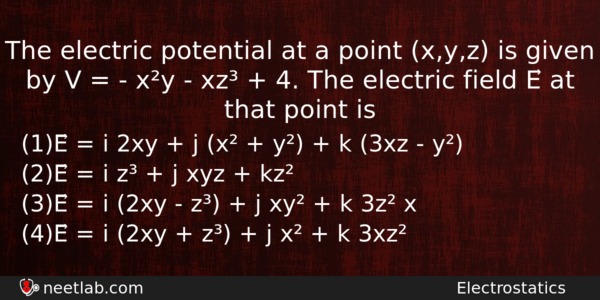| ⇦ | 
| ⇨ |
The electric potential at a point (x,y,z) is given by V = – x²y – xz³ + 4. The electric field E⃗ at that point is
Options
(a) E⃗ = i 2xy + j (x² + y²) + k (3xz – y²)
(b) E⃗ = i z³ + j xyz + kz²
(c) E⃗ = i (2xy – z³) + j xy² + k 3z² x
(d) E⃗ = i (2xy + z³) + j x² + k 3xz²
Correct Answer:
E⃗ = i (2xy + z³) + j x² + k 3xz²
Explanation:
The electric field at a point is equal to negative of potential gradient at that point.
E⃗ = – ?V/ ?r = [ -?V/ ?x i – ?V/ ?y j – ?V/ ?z k ]
E⃗ = i (2xy + z³) + j x² + k 3xz²
Related Questions: - The energy band gap is maximum in
- If the density of earth is doubled keeping its radius constant then acceleration
- A 1kg stone at the end of 1 m long string is whirled in a vertical circle at constant speed
- If c is the velocity of light in free space, the time taken by light to travel
- A transformer having efficiency of 90% is working on 200 V and 3kW power supply
Topics: Electrostatics
(146)
Subject: Physics
(2479)
Important MCQs Based on Medical Entrance Examinations To Improve Your NEET Score
- The energy band gap is maximum in
- If the density of earth is doubled keeping its radius constant then acceleration
- A 1kg stone at the end of 1 m long string is whirled in a vertical circle at constant speed
- If c is the velocity of light in free space, the time taken by light to travel
- A transformer having efficiency of 90% is working on 200 V and 3kW power supply
Topics: Electrostatics (146)
Subject: Physics (2479)
Important MCQs Based on Medical Entrance Examinations To Improve Your NEET Score
18000+ students are using NEETLab to improve their score. What about you?
Solve Previous Year MCQs, Mock Tests, Topicwise Practice Tests, Identify Weak Topics, Formula Flash cards and much more is available in NEETLab Android App to improve your NEET score.
Share this page with your friends

Leave a Reply